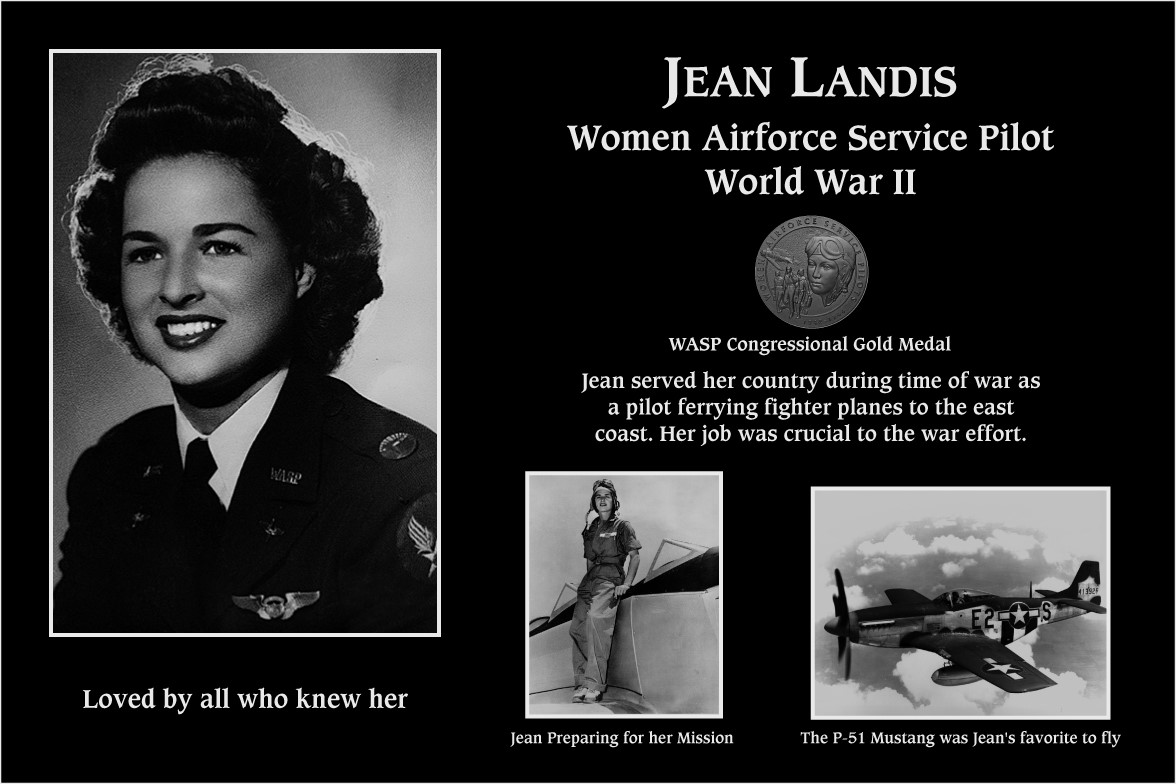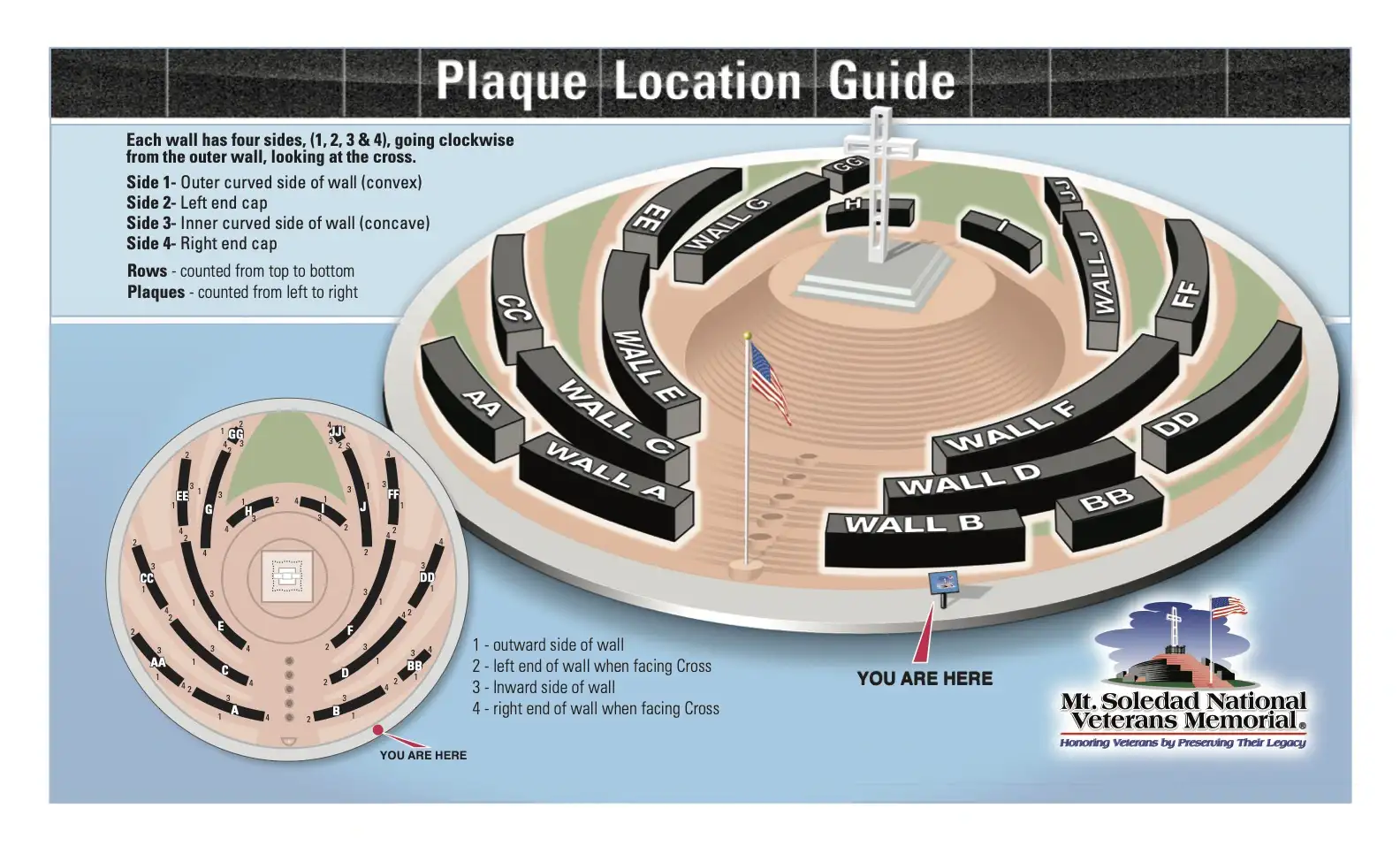Jean Landis

| Era | WWII |
|---|---|
| Branch | Women's Air Force Service Pilots (WASP) - No Ranks |
| Rank | Unknown |
| Wall | CC |
| Wall Side | 1 |
| Row | 1 |
| Plaque Number | 11 |
Jean Landis was born on September 28, 1918, to Felix Landis and Alice Katherine Nesch Landis in the small farming community of El Cajon, California. Jean was the middle child of three — Felix Jr. was two years older, and Jerry was 10 years her junior. Jean was a tomboy and loved sports, the outdoors, and riding her horse Apache Maid bareback through the fields.
After high school, Jean attended San Diego Teachers College (now called SDSU) where she was Homecoming Queen and active in campus clubs. Upon her graduation in 1940 with an A.B. degree in Physical Education, Jean taught at Grossmont High School in San Diego. That same year, she took the first step in pursuing her lifelong dream of flying. Jean joined the Civilian Pilot Training program (CPT).
When the country entered WW II, Jean volunteered and was chosen for the Women Airforce Service Pilots (WASP), a paramilitary organization where women flew military aircraft on non-combat missions, freeing male pilots for combat roles. She was one of a few women trained to fly the P-51 Mustang and spent the bulk of the war flying these amazing machines from the factory in Long Beach, California to Newark, New Jersey where they were loaded onto Liberty cargo ships and sent across the Atlantic. Jean would then fly a P-47 Thunderbolt back across the country where it would be used in battle in the Pacific Theater. She also flew the B-17, C-47, P-39, P-40, and the P-63 on special missions.
Jean served until the WASP program deactivated in 1944. The women who served as WASP went unrecognized as American patriots. That ended when the U.S. Congress passed a bill to award the Congressional Gold Medal — the highest award of honor for civilians — to Jean Landis and all other female WASP pilots, giving them full veteran status.
After the war, Jean went back to teaching physical education, which she loved. She attended graduate school and obtained her M.S. degree from Wellesley College in Massachusetts. During her academic career, she held faculty positions at Park College, West Chester State Teachers College, and Ball State Teachers College. Her last faculty post was at her alma mater, San Diego State. She held the position of Assistant Professor of Physical Education from 1968 until her retirement in 1979, then was awarded the status of Emeritus Assistant Professor of Physical Education.
In 2015, Jean was awarded the SDSU Alumni Association’s prestigious “Monty” award from the College of Health & Human Services in recognition of her contributions to SDSU and the country.
Jean moved to assisted living at Lantern Crest in Santee in 2017 and that is where she peacefully passed on Tuesday, December 13 at the age of 104.
She loved all animals and was a big supporter of animal rights.
******************************
History of the WASP
Over 80 years ago, at a time when America was desperate for gasoline, money for war bonds and a few good men, something extraordinary happened. Young women pilots from all over the United States came to Texas because their country needed them. They came to Texas because they loved to fly.
It all began in 1942 when there was a severe shortage of male pilots. General Hap Arnold, Chief of the Army Air Forces, agreed to have women pilots recruited and trained to fly military aircraft. 25,000 young women from all over America volunteered. 1037 graduated from Army flight training. One of these brave women, was our beloved Aunt and friend, Jean Landis.
When the trainees arrived at Avenger Field they lived in barracks, ate in a mess hall, and followed a strict set of regulations. They marched everywhere, to the barracks. to the mess hall, to their classes and even to the flight line.
Their training program was exactly the same as the male cadets were going through; ground school, flight school, cross country flying, night flying, instrument flying, link trainer flying, and daily calisthenics. At the end of each phase of flight training they were given Army check rides by Army Airforce officers in good weather or bad weather, dust storms or snow up to the propellers.
At graduation, they were honored with a dress parade and graduation ceremony where they received their WASP wings and their Army orders. and officially became Women Airforce Service Pilots. The first women in the history of America to fly military aircraft.
In less than 2 years, The Women Airforce Service Pilots flew more than 60 million miles for their country. 39 of these brave young women made the supreme sacrifice.
On December 7th, 1944, 3 years after Pearl Harbor, General Arnold, now, the Commanding General of the Airforce, spoke at the last graduation saying, “You and more than 900 of your sisters have shown that you can fly wing tip-to wing tip with your brothers. If ever there were any doubt in anyone’s mind that women could become skillful pilots, the WASPs have dispelled that doubt. I salute you and all WASPs. We of the Army Airforce are proud of you. We will never forget our debt to you.”
11 Days later, on December 20th, 1944- over the objections of General Arnold, the WASPs were disbanded. At hundreds of bases all over American, the WASP hung up their Army parachutes for the last time, they packed their bags, and went home.
Jean always said that was a very sad day for her and for our country.
But 66 years later, on March 10, 2010, The Senate and the House of Representatives recognized and awarded the WASPs the Congressional Gold Medal for their service, a revolutionary reform in the Armed Forces during World War II. Even though it took so many years to be recognized as having had military statis, it was well appreciated to be publicly thanked for their service.
Plaque Wall Map

